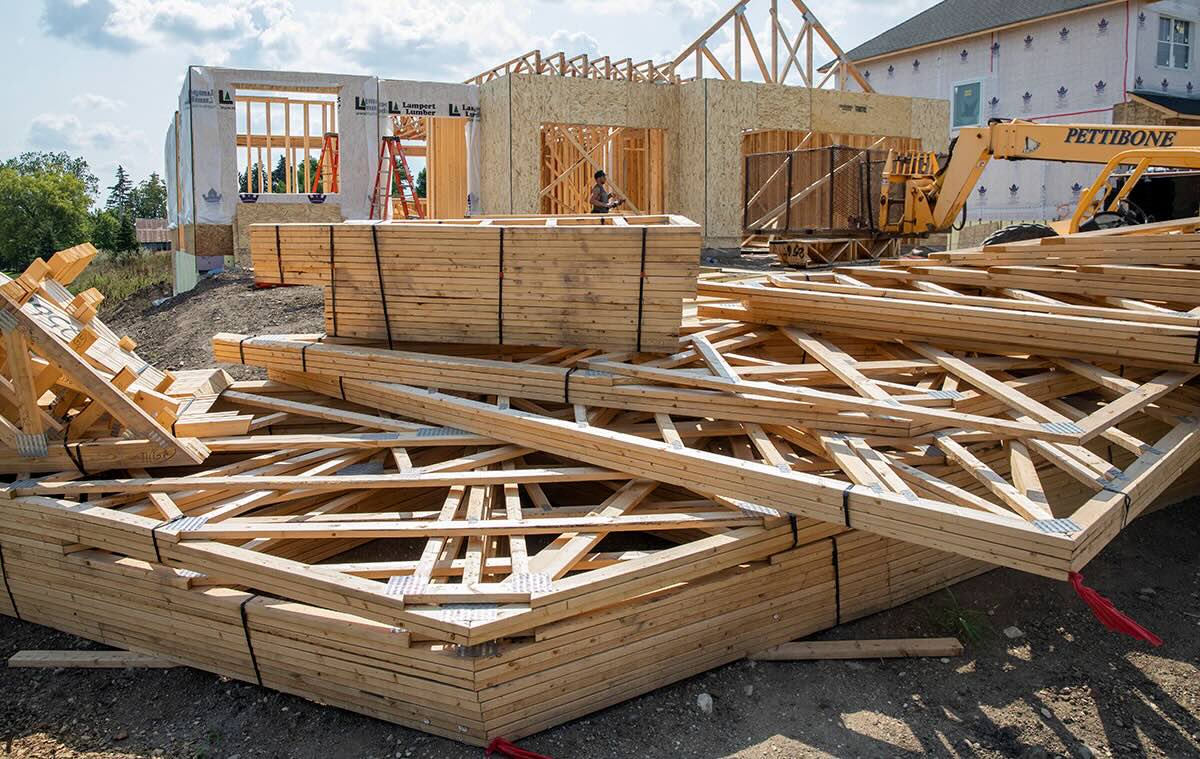Home>diy>Building & Construction>What Is Tender In Construction Industry


Building & Construction
What Is Tender In Construction Industry
Modified: December 7, 2023
Discover what tendering means in the building construction industry, including the process and its importance in securing construction projects. Learn more today!
(Many of the links in this article redirect to a specific reviewed product. Your purchase of these products through affiliate links helps to generate commission for Storables.com, at no extra cost. Learn more)
Introduction
In the dynamic world of construction, the term “tender” holds great significance. Whether you are a contractor, a client, or a professional in the construction industry, understanding the concept of tendering is crucial. Tendering is not just about submitting bids or quotes; it’s a complex process that involves careful planning, evaluation, and decision-making.
Tendering plays a vital role in the construction industry, as it allows clients to select the most suitable contractor for their project. It provides an opportunity for contractors to showcase their skills, expertise, and competitive pricing. In this article, we will delve into the world of tendering, exploring its definition, purpose, types, process, and what it takes to prepare and win a tender.
So, whether you’re new to the construction industry or looking to expand your knowledge, sit back and let’s dive into the fascinating world of tendering in the construction industry.
Key Takeaways:
- Tendering in the construction industry fosters healthy competition, transparency, and innovation. It allows clients to select the best contractor based on expertise, cost-effectiveness, and quality, while encouraging contractors to showcase their skills and creativity.
- The tendering process involves careful planning, thorough evaluation, and effective communication. For contractors, it’s crucial to prepare detailed proposals and submit competitive bids, while clients must conduct fair and transparent tender evaluations to select the most suitable contractor for their projects.
Read more: What Is Tender Document In Construction
Definition of Tender in Construction Industry
In the construction industry, a tender refers to the process of inviting contractors to submit competitive proposals or bids for a construction project. When clients decide to initiate a construction project, they often seek bids from multiple contractors to determine the best candidate for the job.
A tender is essentially a formal invitation for contractors to showcase their capabilities, methodology, and pricing for a particular project. The scope of work, project specifications, and requirements are laid out in the tender documents, which are provided to potential bidders.
The tendering process helps clients evaluate and compare the proposals received from various contractors, enabling them to make an informed decision based on factors such as quality, cost-effectiveness, and track record. Similarly, contractors use the tendering process to assess the feasibility and profitability of a project before deciding to participate.
When a client issues a tender, contractors are given a specific timeframe in which they need to prepare and submit their bids. This period is known as the “tender period” or the “bid submission period.” The contractors are expected to thoroughly review the tender documents, clarify any queries, and submit their proposals within the designated timeframe.
Tendering in the construction industry is typically a competitive process that aims to foster transparency, accountability, and equal opportunities for contractors. It allows clients to select the most suitable contractor for their project, based on a range of factors, including expertise, cost, timeline, and previous performance.
Now that we have a basic understanding of the tendering process in the construction industry, let’s explore the purpose behind tendering in more detail.
Purpose of Tendering
Tendering serves several important purposes in the construction industry. It helps ensure fairness, transparency, and accountability in the selection of contractors for various construction projects. Let’s take a closer look at the key purposes of tendering:
- Encourages Competition: The primary purpose of tendering is to foster healthy competition among contractors. By inviting multiple contractors to submit bids for a project, clients can evaluate and compare different proposals, ensuring that the best contractor is selected based on their capabilities, experience, and pricing.
- Promotes Transparency and Accountability: Tendering promotes transparency and accountability in the construction industry. All contractors are provided with the same set of tender documents, ensuring equal access to project details. By following a standardized process, clients can avoid favoritism or bias in the selection process.
- Obtains the Best Value for Money: Tendering allows clients to obtain the best value for their money. Contractors are required to submit detailed proposals that outline their methodology, materials, and pricing. Clients can evaluate these proposals to identify the most cost-effective option that meets their project requirements.
- Ensures Quality and Expertise: When clients issue tenders, they can attract contractors with specific expertise and track records in the relevant field. Contractors must demonstrate their qualifications and experience in their proposals, ensuring that only qualified and competent contractors are considered for the project.
- Promotes Innovation and Creativity: Tendering encourages contractors to think innovatively and propose creative solutions. Contractors may present alternative approaches, value engineering suggestions, or innovative designs as part of their bids. This promotes a culture of innovation and can lead to improved project outcomes.
Overall, the purpose of tendering in the construction industry is to facilitate a fair and transparent process for selecting the most suitable contractor for a project. It allows clients to assess the expertise, pricing, and quality of contractors’ proposals, ensuring that the chosen contractor can deliver the desired outcomes within the specified parameters.
Types of Tenders
In the construction industry, there are various types of tenders that clients can use to invite contractors to bid on their projects. Each type of tender has its own characteristics and is suited for different project requirements. Let’s explore some of the most common types of tenders:
- Open Tender: An open tender is a type of tender that is open to all interested contractors. The invitation to tender is advertised publicly or through various platforms, allowing any contractor who meets the specified criteria to submit a bid. Open tenders promote maximum competition and are suitable for projects where a wide pool of qualified contractors is desired.
- Selective Tender: In a selective tender, the client pre-selects a limited number of contractors to invite for bidding. The selection is typically based on the contractors’ qualifications, experience, and track record. Selective tenders are commonly used for projects where specific expertise or specialized skills are required.
- Negotiated Tender: A negotiated tender is a type of tender where the client negotiates directly with one or a few selected contractors. This type of tender is often used for complex or high-value projects where the client and contractor need to collaborate closely to finalize the project scope, specifications, and pricing.
- Single-stage Tender: In a single-stage tender, contractors are required to submit their technical and financial proposals together in a single submission. This type of tender is often used for smaller or less complex projects with well-defined project requirements.
- Two-stage Tender: A two-stage tender involves an initial submission of technical proposals, followed by a second submission of financial proposals. The client evaluates the technical proposals in the first stage and shortlists the most suitable contractors, who are then invited to submit their financial proposals in the second stage. Two-stage tenders are commonly used for projects that require more detailed evaluation of technical aspects before finalizing financial aspects.
It’s important for clients to carefully consider the project requirements, complexity, and desired contractor pool when selecting the appropriate type of tender. By choosing the right type, clients can effectively manage the tendering process and ensure a fair and competitive bidding environment.
Tendering Process
The tendering process in the construction industry can vary depending on the specific project and client requirements. However, there are certain key stages that are commonly followed in most tendering processes. Let’s explore the typical steps involved in the tendering process:
- Tender Announcement: The tender process begins with the client announcing the tender. This can be done through public advertisements, online platforms, or direct invitations to selected contractors.
- Tender Documents: The client prepares and shares the tender documents with the potential bidders. These documents include project drawings, specifications, contract terms, scope of work, and any other relevant information necessary for the contractors to submit their proposals.
- Pre-Tender Meetings: In some cases, the client may conduct pre-tender meetings or site visits to provide additional clarification or address any queries from the contractors. These meetings help ensure that all bidders have a clear understanding of the project requirements and can submit accurate and informed proposals.
- Bid Preparation: Contractors review the tender documents thoroughly, analyze the project requirements, and prepare their bids. The bid preparation phase involves estimating costs, planning resources, defining project schedules, assessing risks, and developing a comprehensive proposal that aligns with the client’s requirements.
- Bid Submission: Once the bids are prepared, contractors submit their proposals within the specified timeframe and as outlined in the tender documents. Bids are typically sealed and submitted to the designated person or department responsible for receiving the bids.
- Tender Opening: After the bid submission period ends, the client opens and reviews all the received bids. This process is often carried out in the presence of a tender opening committee to ensure transparency and fairness.
- Tender Evaluation: The client evaluates the received bids based on predefined evaluation criteria, which may include factors such as technical competence, pricing, track record, and compliance with the tender requirements. This evaluation process can involve multiple rounds and may include interviews or presentations by shortlisted bidders.
- Tender Award: Once the evaluation process is complete, the client selects the most suitable contractor and awards them the tender. This involves informing the winning bidder and proceeding with the necessary contractual formalities.
The tendering process requires careful planning, adherence to timelines, effective communication, and thorough evaluation. By following a well-defined process, clients can ensure a fair and transparent selection of the most suitable contractor for their construction project.
When working in the construction industry, it’s important to understand that “tender” refers to the process of inviting bids for a project. Make sure to carefully review and compare all tender submissions to ensure you select the best contractor for the job.
Read more: What Is A Tender Process In Construction?
Preparing and Submitting a Tender
Preparing and submitting a tender in the construction industry is a crucial step for contractors seeking to secure projects. It requires careful planning, attention to detail, and effective communication. Let’s explore the key steps involved in preparing and submitting a tender:
- Review the Tender Documents: Thoroughly review the tender documents provided by the client. Understand the project requirements, specifications, scope of work, and any other relevant details. Identify any ambiguities or areas in need of clarification.
- Clarify Queries: If you have any doubts or need clarification on the tender documents, contact the client for clarification. It’s essential to have a clear understanding of the project requirements to develop an accurate and competitive bid.
- Estimate Costs: Develop a comprehensive cost estimate for the project. This includes labor, materials, equipment, subcontractors, overheads, and contingencies. Use accurate and up-to-date information to ensure your pricing is competitive yet realistic.
- Develop a Work Plan: Create a work plan that outlines the project’s key activities, timelines, and resources required. Consider critical dependencies, potential risks, and any specialized skills or expertise needed for successful project completion.
- Prepare Supporting Documentation: Gather all necessary supporting documentation, such as licenses, certifications, previous project references, and financial statements. These documents help demonstrate your qualifications, experience, and financial stability to the client.
- Write a Detailed Proposal: Craft a well-written and comprehensive proposal that addresses all requirements outlined in the tender documents. Clearly articulate your understanding of the project, proposed methodology, technical approach, and any value-added services you can offer.
- Price your Bid: Set a competitive yet profitable price for your bid. Consider your cost estimate, market conditions, and the client’s expectations. It’s crucial to strike a balance between offering a competitive price and ensuring the project’s profitability for your company.
- Finalize the Bid: Review and proofread your bid to ensure accuracy and professionalism. Pay attention to formatting, spelling, and grammar. Double-check that all required documents and forms are included and properly completed.
- Submit the Bid: Package your bid in accordance with the client’s requirements. Seal and submit it within the designated timeframe. Ensure you meet all the submission deadlines and follow any specific instructions provided by the client.
- Keep Records: Maintain a record of all the documentation, correspondence, and interactions related to your tender submission. This will help you track your bids, understand client preferences, and learn from past experiences.
Preparing and submitting a tender is a detailed and time-consuming process. It requires careful attention to all aspects of the project, from understanding the requirements to developing a compelling proposal and offering a competitive price. By approaching the tender process systematically, you can increase your chances of securing construction projects successfully.
Tender Evaluation
Tender evaluation is a critical stage in the tendering process, as it allows clients to assess the received bids and select the most suitable contractor for their construction project. The evaluation process involves a careful assessment of various factors to ensure a fair and transparent selection. Let’s explore the key aspects of tender evaluation:
- Review Compliance: The client evaluates whether each bid complies with the specified tender requirements. This includes checking for completeness, adherence to submission guidelines, and compliance with technical and contractual specifications.
- Technical Evaluation: The technical aspects of each bid are thoroughly evaluated. The client assesses the proposed methodology, work plan, quality assurance methods, and the contractor’s experience and qualifications. The evaluation may also consider the proposed team, their expertise, and any innovative or value-added approaches suggested.
- Financial Evaluation: The financial proposals are carefully reviewed to ensure accuracy and competitiveness. The client analyzes the pricing structure, cost breakdowns, and overall affordability of each bid. The evaluation may consider factors such as payment terms, warranties, and any allowances or exclusions mentioned.
- Past Performance and References: The client reviews the past performance and references provided by the bidders. This evaluation assesses the contractor’s track record, successful completion of similar projects, and client feedback or testimonials. The aim is to gauge the contractor’s reliability, competence, and ability to deliver high-quality work.
- Risk Assessment: The evaluation process includes a risk assessment of each bid. The client examines the risks associated with the proposed methodology, potential delays, sub-contracting arrangements, and any other factors that may impact the successful completion of the project. This assessment helps identify potential risks and determine the contractor’s ability to mitigate them effectively.
- Interviews or Presentations: In some cases, shortlisted bidders may be invited for interviews or presentations. This allows the client to ask additional questions, seek clarification, or assess the contractor’s ability to communicate effectively. The interviews or presentations can provide valuable insights into the contractor’s approach, problem-solving skills, and overall suitability for the project.
- Weighting and Scoring: The client assigns weights or scores to different evaluation criteria to ensure a structured and consistent evaluation process. This helps in objectively comparing and ranking the bids based on the importance of each criterion.
It’s important to note that the tender evaluation process should be conducted with utmost professionalism, confidentiality, and transparency. Clear guidelines and criteria should be established in advance to ensure a fair and unbiased evaluation of all received bids. Once the evaluation process is complete, the client can proceed with awarding the tender to the most suitable contractor.
Awarding the Tender
After a thorough evaluation of the submitted tenders, the client reaches the final stage of the tendering process: awarding the tender. This crucial step involves selecting the preferred contractor and initiating the necessary contractual formalities. Let’s explore the key considerations and steps involved in awarding a tender:
- Evaluation Decision: Based on the evaluation criteria, the client makes a decision on the preferred bidder. This decision is typically guided by factors such as technical competence, competitive pricing, past performance, and overall suitability for the project.
- Notification: The client notifies the winning bidder and formally communicates the decision. This notification is usually in writing and outlines the details of the project, contractual requirements, and timelines for further actions.
- Contract Negotiation: Once the winning bidder is selected, the client initiates the contract negotiation process. The terms, conditions, and specifications are discussed and finalized in collaboration with the contractor. This negotiation phase ensures that both parties have a clear understanding of the project scope and expectations.
- Contract Award: After successful contract negotiations, the client awards the tender to the selected contractor. This involves signing the contract documents and finalizing any outstanding contractual or administrative requirements.
- Notification to Unsuccessful Bidders: The client informs the unsuccessful bidders about the outcome of the tender evaluation process. This notification may include feedback on their submission or an explanation of why their bid was not selected. It is important to maintain transparency and professionalism in communicating with all bidders.
- Project Kickoff: With the tender awarded, the project kickoff phase begins. The client and contractor collaborate to initiate the project, including establishing project teams, setting up communication channels, and outlining project milestones and deliverables.
- Contract Implementation: The selected contractor begins executing the project as per the agreed contract terms. Regular communication, monitoring, and coordination are essential to ensure the smooth implementation of the project.
- Performance Monitoring: Throughout the project execution, the client monitors the contractor’s performance and adherence to the contract terms. This may involve regular progress updates, site visits, quality inspections, and review of documentation.
- Contract Completion: Upon successful completion of the project, the client formally acknowledges the completion and evaluates the contractor’s performance. This evaluation may influence future working relationships and potential recommendations.
Awarding the tender is a critical milestone in the construction project cycle. It signifies the beginning of a partnership between the client and the contractor. Clear communication, effective contract negotiation, and strong project management contribute to the successful execution of the project and the achievement of the desired outcomes.
Conclusion
Tendering plays a crucial role in the construction industry, enabling clients to select the most suitable contractor for their projects and providing contractors with opportunities to showcase their expertise and secure work. Throughout the tendering process, various stages are followed, including tender announcement, documentation, preparation, submission, evaluation, and ultimately, the awarding of the tender.
By understanding the tendering process, contractors can effectively prepare and submit competitive bids that align with the client’s requirements. It involves thorough review and understanding of the tender documents, accurate cost estimation, development of detailed proposals, and submission within the designated timeframe.
For clients, tender evaluation is an essential part of the process, allowing them to assess the technical and financial aspects of the bids, review past performance, and select the most suitable contractor. Transparency, fairness, and adherence to evaluation criteria are crucial to ensure a successful outcome.
Once the tender has been awarded, the client and contractor can enter into a contractual agreement, negotiate the terms, and initiate the project. Throughout the project lifecycle, effective communication, project management, and performance monitoring contribute to the successful completion of the project.
In conclusion, tendering in the construction industry is a complex yet vital process that enables clients to find the right contractors and contractors to secure valuable projects. By following a systematic and transparent approach, both clients and contractors can benefit from the tendering process, leading to successful project outcomes and mutually beneficial partnerships.
Frequently Asked Questions about What Is Tender In Construction Industry
Was this page helpful?
At Storables.com, we guarantee accurate and reliable information. Our content, validated by Expert Board Contributors, is crafted following stringent Editorial Policies. We're committed to providing you with well-researched, expert-backed insights for all your informational needs.















0 thoughts on “What Is Tender In Construction Industry”